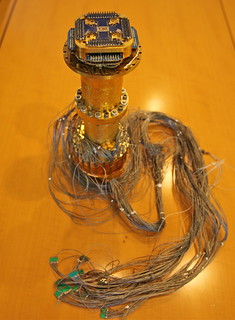| D-Wave Orion (Photo credit: jurvetson) |
-----
This is me, I am very curious to keep track of the developments in the computing world, and having to post this article a year after its publication would give me more insights on what happened afterwards. Did it click? Or did it bomb out? We can all know the answer, a glimpse if not the totality, from other publications. Read on...
-----
by Quentin Hardy
VANCOUVER, British Columbia -- Our digital age is all about bits, those precise ones and zeros that are the stuff of modern computer code.
But a powerful new type of computer that is about to be commercially deployed by a major American military contractor is taking computing into the strange, subatomic realm of quantum mechanics. In that infinitesimal neighborhood, common sense logic no longer seems to apply. A one can be a one, or it can be a one and a zero and everything in between -- all at the same time.
It sounds preposterous. But academic researchers and scientists have been working to develop quantum computers.
Now, Lockheed Martin -- which bought an early version of such a computer from the Canadian company D-Wave Systems two years ago -- is confident enough in the technology to upgrade it to commercial scale, becoming the first company to use quantum computing as part of its business.
If it performs as Lockheed and D-Wave expect, the design could be used to supercharge even the most powerful systems, solving some science and business problems millions of times faster than can be done today.
Ra Johnson, Lockheed's chief technical officer, said his company would use the quantum computer to create and test complex radar, space and aircraft systems. It could be possible, for example, to tell instantly how the millions of lines of software running a network of satellites would react to a solar burst or a pulse from a nuclear explosion -- something that can now take weeks, if ever, to determine.
"This is a revolution not unlike the early days of computing," he said. "It is a transformation in the way computers are thought about."
Many others could find applications for D-Wave's computers. Cancer researchers see a potential to move rapidly through vast amounts of genetic data. The technology could also be used to determine the behavior of proteins encoded by the human genome. Researchers at Google have worked with D-Wave on using quantum computers to recognize cars and landmarks, a critical step in managing self-driving vehicles.
Quantum computing is so much faster than traditional computing because of the unusual properties of particles at the smallest level. Instead of the precision of ones and zeros that have been used to represent data since the earliest days of computers, quantum computing relies on the fact that subatomic particles inhabit a range of states. Those states can be narrowed to determine an optimal outcome among a near-infinitude of possibilities, which allows certain types of problems to be solved rapidly.
"What we're doing is a parallel development to the kind of computing we've had for the past 70 years," said Vern Brownell, chief executive of D-Wave, a 12-year-old company based in Vancouver.
D-Wave, and the broader vision of quantum-supercharged computing, are not without their critics. Much of the criticism stems from D-Wave's own claims in 2007, later withdrawn, that it would produce a commercial quantum computer within a year.
D-Wave "has said things in the past that were just ridiculous, things that give you very little confidence," said Scott Aaronson, of the Massachusetts Institute of Technology.
But others say people working in quantum computing are generally optimistic about breakthroughs to come. Quantum researchers "are taking a step out of the theoretical domain and into the applied," said Peter Lee, the head of Microsoft's research arm. "There is a sense among top researchers that we're all in a race."
-----
Taken from TODAY Saturday Edition, April 06, 2013























































